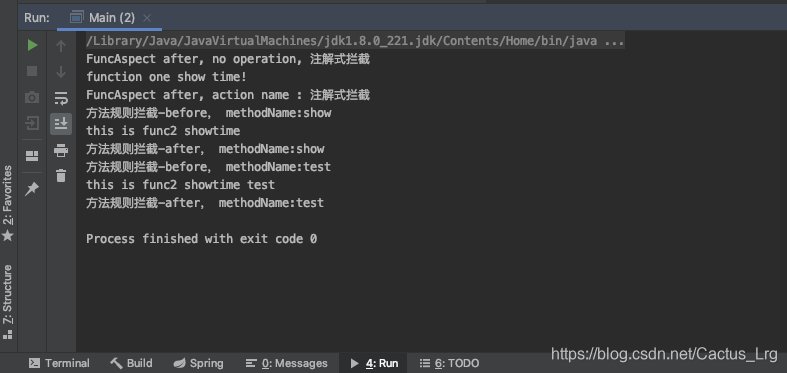Spring框架的四大原则:
- 使用POJO进行轻量级和最小侵入式开发
- 通过依赖注入和基于接口编程实现松耦合
- 通过AOP和默认习惯进行声明式编程
- 使用AOP和模板(template)减少模式化代码
一、依赖注入
1.依赖注入的概念:
依赖注入是指容器负责创建对象和维护对象间的依赖关系,而非通过对象本身负责自己的创建和解决自己的依赖。
2.依赖注入的主要目的:
主要目的就是解耦,所体现的是java组合的理念。毫无疑问组合相对于继承,耦合度会大大降低。
3.具体实现
Spring IoC容器(ApplicationContext)负责创建Bean,并通过容器将功能类Bean注入到你所需要的Bean中。
Spring提供xml、注解、Java配置,这三种方式都被称为配置元数据。即描述数据的数据,本身不具备任何执行能力,只能通过外界代码对元数据解析后进行一些有意义的操作。
4.涉及到的注解(推荐注解的方式,xml效率低且复杂)
声明式Bean的注解:
- @Component 没有明确角色
- @Service 业务逻辑层使用
- @Repository 数据访问层使用
- @Controller 展现层使用(提供接口的方法类)
注入Bean的注解
- @Autowired Spring提供的注解(通常使用这个)
- @Inject JSR-330提供的注解
- @Resource JSR-250提供的注解
(注入Bean的注解 可注解到set方法上或者属性上,具体根据实际开发场景选择)
5.Ioc&Di Demo
方法bean1
package com.cactus.iocdidemo;
import org.springframework.stereotype.Service;
/**
* Created by liruigao
* Date: 2019-10-11 11:02
* Description:
* 1. @Service 声明FuncOneService为bean
*/
@Service
public class FuncOneService {
public String show(String word) {
return "Function one show : " + word;
}
}
方法bean2
package com.cactus.iocdidemo;
import org.springframework.beans.factory.annotation.Autowired;
import org.springframework.stereotype.Service;
/**
* Created by liruigao
* Date: 2019-10-11 11:03
* Description:
* 1. @Service 声明 FuncTwoService 为bean
* 2. @Autowired 将 FuncOneService 注入到 FuncTwoService
*/
@Service
public class FuncTwoService {
@Autowired
private FuncOneService funcOneService;
public String show(String word) {
return funcOneService.show(word);
}
}
配置类
package com.cactus.iocdidemo;
import org.springframework.context.annotation.ComponentScan;
import org.springframework.context.annotation.Configuration;
/**
* Created by liruigao
* Date: 2019-10-11 11:07
* Description:
* 1. @Configuration 声明注册类
* 2. @ComponentScan扫描指定包,并注册为Bean
*/
@Configuration
@ComponentScan("com.cactus.iocdidemo")
public class BeanConfig {
}
Main
package com.cactus.iocdidemo;
import org.springframework.context.annotation.AnnotationConfigApplicationContext;
/**
* Created by liruigao
* Date: 2019-10-11 11:05
* Description:
*/
public class Main {
public static void main(String[] args) {
// 使用AnnotationConfigApplicationContext容器,并选择BeanConfig为配置类
AnnotationConfigApplicationContext context = new AnnotationConfigApplicationContext(BeanConfig.class);
// bean已有容器创建,从容器中获取方法bean
FuncTwoService funcTwoService = context.getBean(FuncTwoService.class);
String showWord = funcTwoService.show("hi ioc&di");
System.out.println(showWord);
context.close();
}
}
result:

二、Java配置
1.Java配置简介
Java配置是Spring 4.x和Spring Boot推荐的配置方式,可以完全替代xml配置。
通过@Configuration和@Bean来实现:
- @Configuration 声明当前类是个配置类,相当于一个xml文件
- @Bean 注解到方法上,声明当前方法返回值是个Bean
2.什么时候使用Java配置
全局配置使用java配置,如数据库相关配置、MVC相关配置
业务Bean的配置使用注解配置,如@Service、@Component、@Repository、@Controller
3.JavaConfig demo
FuncOneService
package com.cactus.javaconfigdemo;
/**
* Created by liruigao
* Date: 2019-10-11 11:33
* Description: 普通方法类,不声明为Bean
*/
public class FuncOneService {
public String show(String word) {
return "java config, Function one show : " + word;
}
}
FuncTwoService
package com.cactus.javaconfigdemo;
/**
* Created by liruigao
* Date: 2019-10-11 11:34
* Description:普通方法类, 不声明为bean, 不依赖注入
*/
public class FuncTwoService {
private FuncOneService funcOneService;
public void setFuncOneService(FuncOneService funcOneService) {
this.funcOneService = funcOneService;
}
public String show(String word) {
return funcOneService.show(word);
}
}
JavaConfig
package com.cactus.javaconfigdemo;
import org.springframework.context.annotation.Bean;
import org.springframework.context.annotation.ComponentScan;
import org.springframework.context.annotation.Configuration;
/**
* Created by liruigao
* Date: 2019-10-11 11:36
* Description:
* 1. 声明为配置类
* 2. 无需进行包扫描,因为所有的bean都在这里定义
* 3. 通过使用@Bean注解, 可以更加灵活地创建管理Bean
*/
@Configuration
public class JavaConfig {
@Bean
public FuncOneService funcOneService() {
return new FuncOneService();
}
@Bean
public FuncTwoService funcTwoService() {
FuncTwoService funcTwoService = new FuncTwoService();
funcTwoService.setFuncOneService(funcOneService());
return funcTwoService;
}
}
Main
package com.cactus.javaconfigdemo;
import org.springframework.context.annotation.AnnotationConfigApplicationContext;
/**
* Created by liruigao
* Date: 2019-10-11 11:43
* Description:
*/
public class Main {
public static void main(String[] args) {
AnnotationConfigApplicationContext context = new AnnotationConfigApplicationContext(JavaConfig.class);
FuncTwoService funcTwoService = context.getBean(FuncTwoService.class);
System.out.println(funcTwoService.show("hi javaConfig"));
context.close();
}
}
result

三、AOP
1.AOP的由来
AOP: 面向切面编程
OOP引入封装、继承和多态性等概念来建立一种对象层次结构,用以模拟公共行为的一个集合。当我们需 要为分散的对象引入公共行为的时候,OOP则显得无能为力。也就是说,OOP允许你定义从上到下的关系,但并不适合定义从左到右的关系。
AOP技术利用一种称为“横切”的技术,剖解开封装的对象内部,并将那些影响了多个类的公共行为封装到一个可重用模块,并将其名为 “Aspect”,即方面。所谓“方面”,简单地说,就是将那些与业务无关,却为业务模块所共同调用的逻辑或责任封装起来,便于减少系统的重复代码,降低 模块间的耦合度,并有利于未来的可操作性和可维护性。
AOP代表的是一个横向的关系,如果说“对象”是一个空心的圆柱体,其中封装的是对象的属性和行为; 那么面向方面编程的方法,就仿佛一把利刃,将这些空心圆柱体剖开,以获得其内部的消息。而剖开的切面,也就是所谓的“方面”了。然后它又以巧夺天功的妙手 将这些剖开的切面复原,不留痕迹。
2.AOP的目的
Spring AOP存在的目的就是为了解耦。 让一组类共享相同的行为
3.涉及到的注解
切面编程涉及到的注解:
- @Aspect 声明一个切面
- @PointCut 声明一个切点
- @Before, @After, @Around 定义建言, 可直接将切点(或者方法拦截规则)作为参数
创建一个注解所涉及到的注解:
- @interface 声明一个注解
- @Target 用于描述注解的使用范围
- @Retention 用于描述一个注解存在的生命周期
4.AOP Demo
pom文件
<?xml version="1.0" encoding="UTF-8"?>
<project xmlns="http://maven.apache.org/POM/4.0.0"
xmlns:xsi="http://www.w3.org/2001/XMLSchema-instance"
xsi:schemaLocation="http://maven.apache.org/POM/4.0.0 http://maven.apache.org/xsd/maven-4.0.0.xsd">
<modelVersion>4.0.0</modelVersion>
<groupId>com.cactus</groupId>
<artifactId>springdemo</artifactId>
<version>1.0-SNAPSHOT</version>
<dependencies>
<!-- Spring容器-->
<dependency>
<groupId>org.springframework</groupId>
<artifactId>spring-context</artifactId>
<version>5.1.9.RELEASE</version>
</dependency>
<!-- Aop-->
<dependency>
<groupId>org.springframework</groupId>
<artifactId>spring-aop</artifactId>
<version>5.1.9.RELEASE</version>
</dependency>
<!-- aspectj-->
<dependency>
<groupId>org.aspectj</groupId>
<artifactId>aspectjrt</artifactId>
<version>1.8.13</version>
</dependency>
<dependency>
<groupId>org.aspectj</groupId>
<artifactId>aspectjweaver</artifactId>
<version>1.8.13</version>
</dependency>
</dependencies>
</project>
拦截注解
package com.cactus.aopdemo;
import java.lang.annotation.ElementType;
import java.lang.annotation.Retention;
import java.lang.annotation.RetentionPolicy;
import java.lang.annotation.Target;
/**
* Created by liruigao
* Date: 2019-10-11 15:01
* Description: 拦截规则的注解
* 1. @Target
* 用于描述注解的使用范围
* ElementType枚举类型,元注解中的枚举值决定了一个注解可以标记的范围
* TYPE : 类型上面 用于描述类、接口(包括注解类型) 或enum声明
* FIELD : 用于描述字段
* METHOD :方法
* PARAMETER : 参数 【参数名】
* CONSTRUCTOR : 构造方法
* LOCAL_VARIABLE : 局部变量
* ANNOTATION_TYPE : 可以打在注解上面
* PACKAGE :可以打在包上面
* TYPE_PARAMETER : 参数类型【形式参数类型】
*2. @Retention
* 用于描述一个注解存在的生命周期【源码,字节码文件,运行时】
* 枚举值RetentionPolicy:几个值决定了几个状态:
* SOURCE :表示一个注解可以存在于源码中==>java的源码中
* CLASS :表示 一个注解可以在源码中,并且可以在字节码文件中
* RUNTIME :表示 一个注解可以在源码、字节码、及运行时期该注解都会存在
*
*/
@Target(ElementType.METHOD)
@Retention(RetentionPolicy.RUNTIME)
public @interface Action {
String name();
}
被拦截类1
package com.cactus.aopdemo;
import org.springframework.stereotype.Service;
/**
* Created by liruigao
* Date: 2019-10-11 15:16
* Description:
* 被拦截类,使用拦截注解
*/
@Service
public class FuncOneService {
@Action(name = "注解式拦截")
public void show() {
System.out.println("function one show time!");
}
}
被拦截类2
package com.cactus.aopdemo;
import org.springframework.stereotype.Service;
/**
* Created by liruigao
* Date: 2019-10-11 15:42
* Description:
* 被拦截类, 使用方法规则拦截
*/
@Service
public class FuncTwoService {
public void show() {
System.out.println("this is func2 showtime");
}
public void test() {
System.out.println("this is func2 showtime test");
}
}
切面类
package com.cactus.aopdemo;
import org.aspectj.lang.JoinPoint;
import org.aspectj.lang.annotation.After;
import org.aspectj.lang.annotation.Aspect;
import org.aspectj.lang.annotation.Before;
import org.aspectj.lang.annotation.Pointcut;
import org.aspectj.lang.reflect.MethodSignature;
import org.springframework.stereotype.Component;
import java.lang.reflect.Method;
/**
* Created by liruigao
* Date: 2019-10-11 15:19
* Description: 切面类
* @Aspect 声明切面
* @Component 声明Bean
* @Pointcut 声明切点
* @After 声明一个建言,并使用@Pointcut声明的切点。
*/
@Aspect
@Component
public class FuncAspect {
// 使用注解拦截-start
@Pointcut("@annotation(com.cactus.aopdemo.Action)")
public void annotationPointCut(){};
// 可通过反射获得注解上的属性,然后做自定义操作
@After("annotationPointCut()")
public void after(JoinPoint joinPoint) {
MethodSignature signature = (MethodSignature)joinPoint.getSignature();
Method method = signature.getMethod();
Action action = method.getAnnotation(Action.class);
System.out.println("FuncAspect after, action name : " + action.name());
}
@Before("annotationPointCut()")
public void before(JoinPoint joinPoint) {
System.out.println("FuncAspect after, no operation, 注解式拦截");
}
// 使用注解拦截-end
// 使用方法规则拦截-start
@Before("execution(* com.cactus.aopdemo.FuncTwoService.*(..))")
public void beforef(JoinPoint joinPoint) {
MethodSignature signature = (MethodSignature)joinPoint.getSignature();
Method method = signature.getMethod();
System.out.println("方法规则拦截-before, methodName:" + method.getName());
}
@After("execution(* com.cactus.aopdemo.FuncTwoService.*(..))")
public void afterf(JoinPoint joinPoint) {
MethodSignature signature = (MethodSignature)joinPoint.getSignature();
Method method = signature.getMethod();
System.out.println("方法规则拦截-after, methodName:" + method.getName());
}
// 使用方法规则拦截-end
}
配置类
package com.cactus.aopdemo;
import org.springframework.context.annotation.ComponentScan;
import org.springframework.context.annotation.Configuration;
import org.springframework.context.annotation.EnableAspectJAutoProxy;
/**
* Created by liruigao
* Date: 2019-10-11 15:38
* Description: AOP demo 配置类
* @EnableAspectJAutoProxy 开启Spring对AspectJ的支持
*/
@Configuration
@ComponentScan("com.cactus.aopdemo")
@EnableAspectJAutoProxy
public class AopConfig {
}
Main
package com.cactus.aopdemo;
import org.springframework.context.annotation.AnnotationConfigApplicationContext;
/**
* Created by liruigao
* Date: 2019-10-11 15:37
* Description:
*/
public class Main {
public static void main(String[] args) {
AnnotationConfigApplicationContext context = new AnnotationConfigApplicationContext(AopConfig.class);
FuncOneService funcOneService = context.getBean(FuncOneService.class);
FuncTwoService funcTwoService = context.getBean(FuncTwoService.class);
// 注解式拦截
funcOneService.show();
// 方法规则式拦截
funcTwoService.show();
funcTwoService.test();
context.close();
}
}
result























 2802
2802











 被折叠的 条评论
为什么被折叠?
被折叠的 条评论
为什么被折叠?










